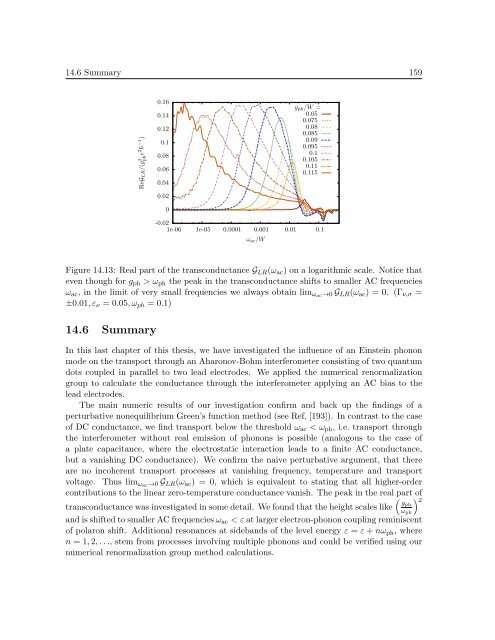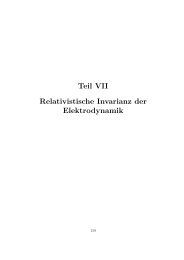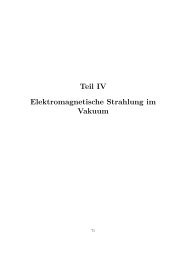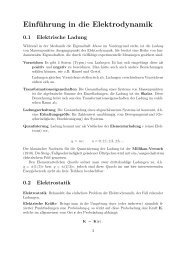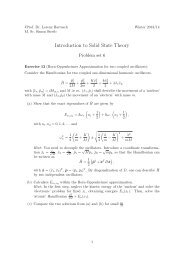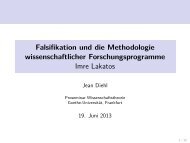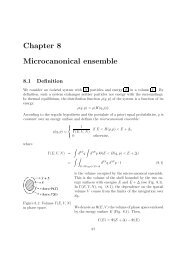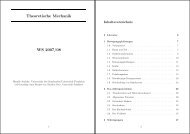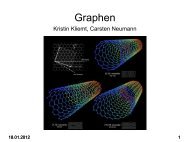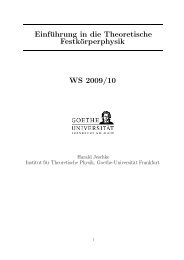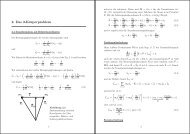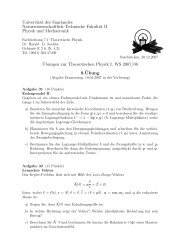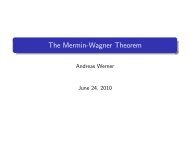A Numerical Renormalization Group Approach to Dissipative ...
A Numerical Renormalization Group Approach to Dissipative ...
A Numerical Renormalization Group Approach to Dissipative ...
Create successful ePaper yourself
Turn your PDF publications into a flip-book with our unique Google optimized e-Paper software.
14.6 Summary 159<br />
ReGLR/(g 2 ph e2 ¯h −1 )<br />
0.16<br />
0.14<br />
0.12<br />
0.1<br />
0.08<br />
0.06<br />
0.04<br />
0.02<br />
0<br />
-0.02<br />
1e-06 1e-05 0.0001 0.001 0.01 0.1<br />
ωac/W<br />
gph/W =<br />
0.05<br />
0.075<br />
0.08<br />
0.085<br />
0.09<br />
0.095<br />
0.1<br />
0.105<br />
0.11<br />
0.115<br />
Figure 14.13: Real part of the transconductance GLR(ωac) on a logarithmic scale. Notice that<br />
even though for gph > ωph the peak in the transconductance shifts <strong>to</strong> smaller AC frequencies<br />
ωac, in the limit of very small frequencies we always obtain limωac→0 GLR(ωac) = 0. (Γν,σ =<br />
±0.01, εν = 0.05, ωph = 0.1)<br />
14.6 Summary<br />
In this last chapter of this thesis, we have investigated the influence of an Einstein phonon<br />
mode on the transport through an Aharonov-Bohm interferometer consisting of two quantum<br />
dots coupled in parallel <strong>to</strong> two lead electrodes. We applied the numerical renormalization<br />
group <strong>to</strong> calculate the conductance through the interferometer applying an AC bias <strong>to</strong> the<br />
lead electrodes.<br />
The main numeric results of our investigation confirm and back up the findings of a<br />
perturbative nonequilibrium Green’s function method (see Ref. [193]). In contrast <strong>to</strong> the case<br />
of DC conductance, we find transport below the threshold ωac < ωph, i.e. transport through<br />
the interferometer without real emission of phonons is possible (analogous <strong>to</strong> the case of<br />
a plate capacitance, where the electrostatic interaction leads <strong>to</strong> a finite AC conductance,<br />
but a vanishing DC conductance). We confirm the naive perturbative argument, that there<br />
are no incoherent transport processes at vanishing frequency, temperature and transport<br />
voltage. Thus limωac→0 GLR(ωac) = 0, which is equivalent <strong>to</strong> stating that all higher-order<br />
contributions <strong>to</strong> the linear zero-temperature conductance vanish. The peak in the real part of<br />
2 gph<br />
transconductance was investigated in some detail. We found that the height scales like ωph<br />
and is shifted <strong>to</strong> smaller AC frequencies ωac < ε at larger electron-phonon coupling reminiscent<br />
of polaron shift. Additional resonances at sidebands of the level energy ε = ε + nωph, where<br />
n = 1, 2, . . ., stem from processes involving multiple phonons and could be verified using our<br />
numerical renormalization group method calculations.


